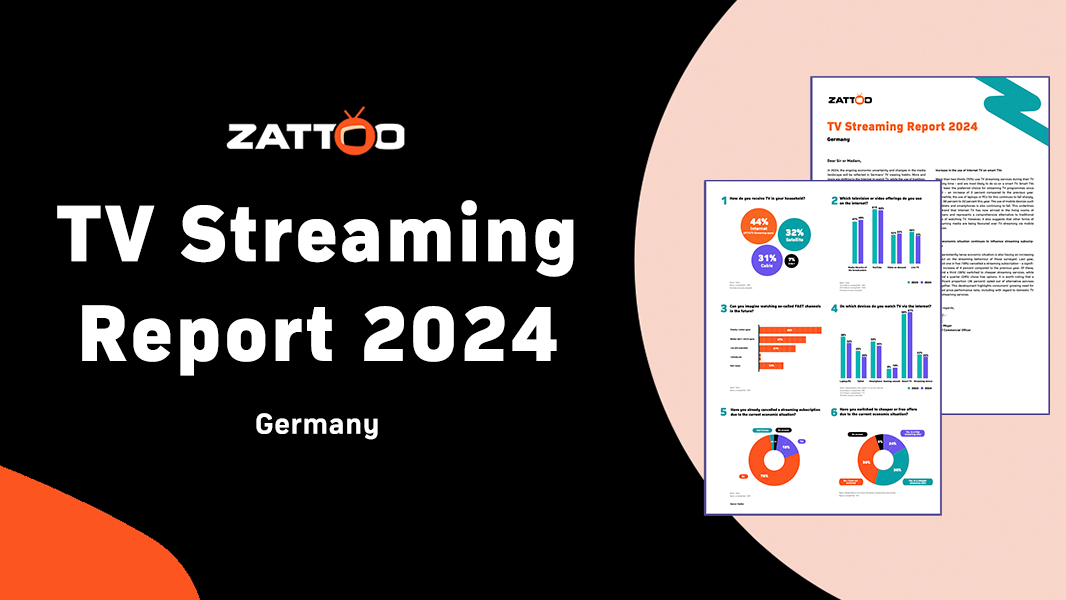Press release
Zattoo's 2024 TV Streaming Report for Germany
More and more people are opting for the Internet as their main mode for watching TV

Berlin, 3rd April 2024 – In 2024, the ongoing economic uncertainty and changes in the media landscape will be reflected in Germans' TV viewing habits. More and more people are turning to the Internet to watch TV, while the use of traditional cable reception continues to decline. This trend will continue due to discontinuation of the so-called Nebenkostenprivileg (ancillary cost privilege) on 1 July 2024. This is the result of Zattoo's 2024 TV Streaming Report for Germany this year.
The report is based on an online survey conducted by YouGov, in which 1081 people in Germany took part between 15 January 2024 and 22 January 2024. The results were weighted and are representative of the German population aged 16 and over. Zattoo has been conducting this survey in Germany every year since 2015. The TV Streaming Report helps identify current developments in Internet and television usage as well as TV streaming. In this way, Zattoo aims to contribute to the discussion on the importance of TV streaming.
Internet TV continues to grow, whereas cable TV is losing significant ground
The trend towards television via the Internet will continue in 2024. When asked which way they use to watch TV (multiple answers possible), 44 percent of respondents choose the Internet as their way of watching TV. That is another 3 percent more than in 2023, while watching TV via traditional cable continues to decline. Only around one in three (31%) watch cable TV. That is a whole 8 percent less than in the previous year. Watching TV via satellite (32%) and DVB-T (7%) also fell by 3 percent each this year.
Jörg Meyer, Chief Commercial Officer at Zattoo, categorises the development as follows: "In view of being able to give multiple answers in our survey, it is evident that there is a clear shift in TV reception behaviour. While traditional reception modes such as cable, satellite and DVB-T are losing popularity significantly, there is continued growth in the use of Internet TV. This highlights the trend that the Internet is becoming the primary reception mode to watch TV for more and more people. This development will be further fuelled by the effects of the so-called Nebenkostenprivileg, which ends in July."n des im Juli endenden sogenannten Nebenkostenprivilegs zusätzlich vorangetrieben wird."
The use of live TV: back to the 2022 level
This year, 31 percent of respondents said they watch live TV content. This is a decline of 5 percent for traditional TV compared to the previous year. In contrast, the use of media libraries, YouTube and video-on-demand services remains stable. The fact that one in three (36%) can already imagine watching linear-themed channels, so-called FAST channels, in the future suggests a growing interest in alternative, ad-supported TV content.
Increase in the use of Internet TV on smart TVs
More than two thirds (70%) use TV streaming services during their TV viewing time – and are most likely to do so on a smart TV. Smart TVs have been the preferred choice for streaming TV programmes since 2020 – an increase of 2 percent compared to the previous year. Meanwhile, the use of laptops or PCs for this continues to fall sharply, from 38 percent to 32 percent this year. The use of mobile devices such as tablets and smartphones is also continuing to fall. This underlines the trend that Internet TV has now arrived in the living rooms of Germans and represents a comprehensive alternative to traditional ways of watching TV. However, it also suggests that other forms of consuming media are being favoured over TV streaming via mobile devices.
The economic situation continues to influence streaming subscriptions
The persistently tense economic situation is also having an increasing impact on the streaming behaviour of those surveyed. Last year, almost one in five (18%) cancelled a streaming subscription – a significant increase of 4 percent compared to the previous year. Of these, around a third (36%) switched to cheaper streaming services, while around a quarter (24%) chose free options. It is worth noting that a significant proportion (36 percent) opted out of alternative services altogether. This development highlights consumers' growing need for a good price-performance ratio, including with regard to domestic TV and streaming services.
You can download the TV Streaming Report 2024 for Germany here or visit our website at https://zattoo.com/de/en/tv-streaming-report-de.
The individual graphics for the report can be found here.
Please indicate the following copyright: © Zattoo AG